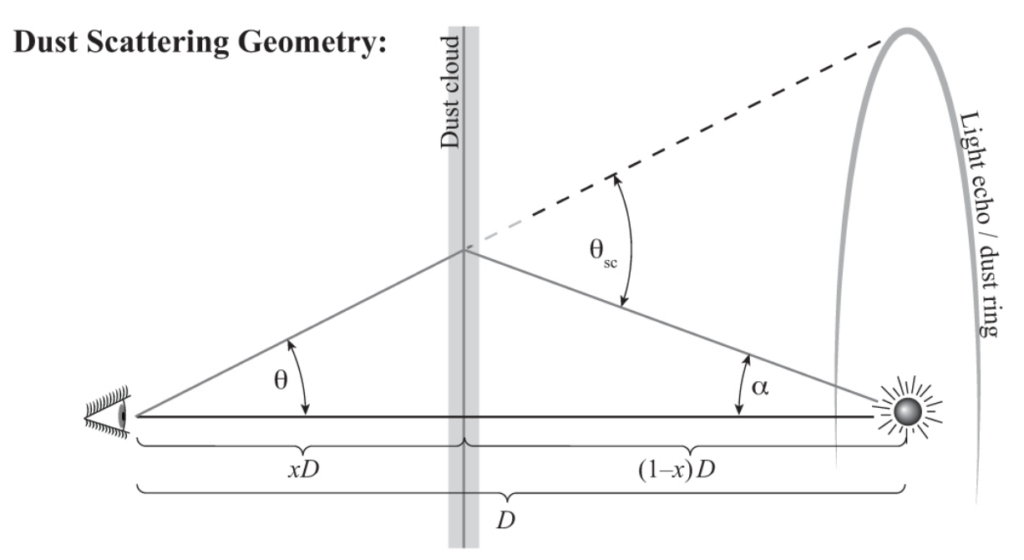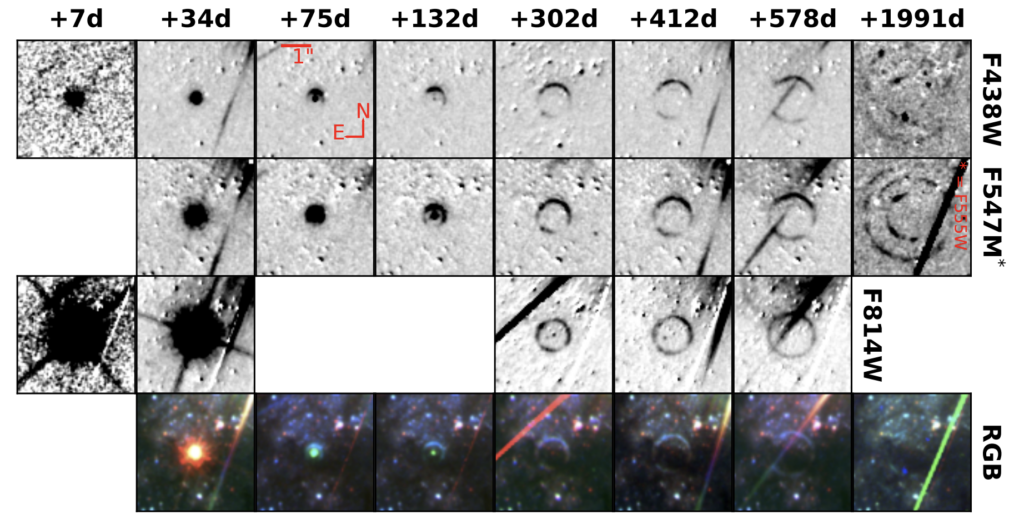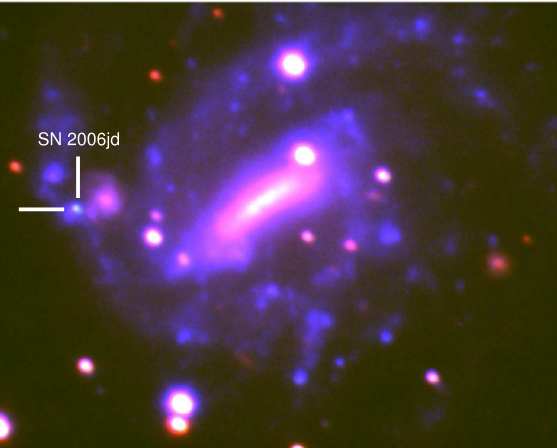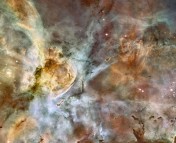Authors: M.D. Stritzinger, F. Taddia, S. Lawrence et al.
First Author’s Institution: Aarhus University, Denmark
Status: arxiv [open access]
The deaths of massive stars are announced by spectacular explosions, termed as supernovae. If the conditions around the exploding stars are just right, echoes of this explosion can be observed! Today’s paper presents stunning images of echoes observed for a supernova in the nearby galaxy Centaurus A.
What are light echoes?
An echo requires two ingredients – a wave and a reflecting surface. Sound echoes are caused by sound waves reflecting off the walls of a cave or a mountain. Similarly, light echoes are caused by light (waves) reflecting off something called “dust clouds” in the galaxy of the supernova.
Light from the extremely luminous supernova illuminates the interstellar medium (ISM) extending for several hundreds of parsecs around the exploding star. This ISM usually contains large quantities of space “dust”. Space dust is essentially tiny particles of solid material, composed mainly of carbon and some other metals. These dust particles can vary in size – from a few microns to a few millimeters, and pervade large regions of a galaxy. You can make out the large dust clouds of the Milky Way even with the naked eye on a clear night. These dust particles are very efficient scatterers of light.
Under normal circumstances, an astronomer looking at a supernova will only see light coming from the supernova explosion. However, if the geometry and orientation of the dust clouds around the supernova are just right, they could also see the scattered light coming from these dust clouds! This scattered light is called the “light echo” of the supernova. These echoes are often seen as circular rings, as shown in Figure 1. The angular extent of these rings is typically very small. We thus need telescopes with extremely high angular resolution to observe them. Additionally, the observed angular extent of the rings scales inversely as the distance to the supernova (recall trigonometry). Supernova light echos are thus observable only for extremely nearby explosions, making them an observationally rare phenomenon.

Light echoes of SN2016adj
The authors of today’s paper focused on finding the light echoes of the supernova SN 2016adj. This supernova was discovered in 2016 by the Backyard Observatory Supernova Search team, in the extremely nearby galaxy Centaurus A. The authors imaged the location of this supernova using the Hubble Space Telescope on eight epochs between 2016 to 2021. Their observations were conducted using three filters that spanned the visual wavelength range, from 440 nm to 814 nm. The exquisite angular resolution of HST enabled the authors to detect not one, but multiple light echo rings from this supernova! These images are shown in Figure 2.
As seen from Figure 2, the authors identify four distinct light echo components from the supernova. As expected, the innermost rings are generally seen at early times, while the outer rings become visible only at later epochs when light from the supernova has reached the more distant dust clouds. The authors note that their first light echo is seen 75 days after the explosion, and is the earliest detection of a light echo in a supernova ever.

What does the echo tell us?
Light echoes are a powerful tool to probe the structure of the interstellar medium in the galaxy of the supernova. Using the observed angular radius of the SN2016adj echo rings, the authors calculated the distance between the supernova and the dust clouds that produced each ring. They find that all light echos were produced within 60-320 parsecs of the exploding star (for context, the total extent of the Cen-A galaxy is more than 20000 parsecs). They also measure the thickness of the individual dust clouds, which ranges from 16 parsecs to ~100 parsecs.
The authors also measured the total intensity of light coming from each echo, and how the echo brightness evolves with time. Using the relative fluxes in the three filters, they calculate the “optical depth” of each dust cloud. The optical depth parametrizes how much light a dust cloud absorbs, and thus is a measure of the cloud’s density and the spatial extent (more dense, larger size = more absorption of light). Using this information, they construct a simple 2D-map of the dust around this supernova. This map consists of four patchy dust-sheets, where each sheet has big holes in it as the dust is distributed inhomogeneously.
The authors note that it is possible to construct a full 3D map of the dust using these observations, which they will attempt to do in a future study. Additional HST observations of this supernova will trace the late-time evolution of the light echoes, and also potentially identify additional echoes!
Edited by Katy Proctor
Featured image credit : NASA, ESA and H.E. Bond (STScI)




